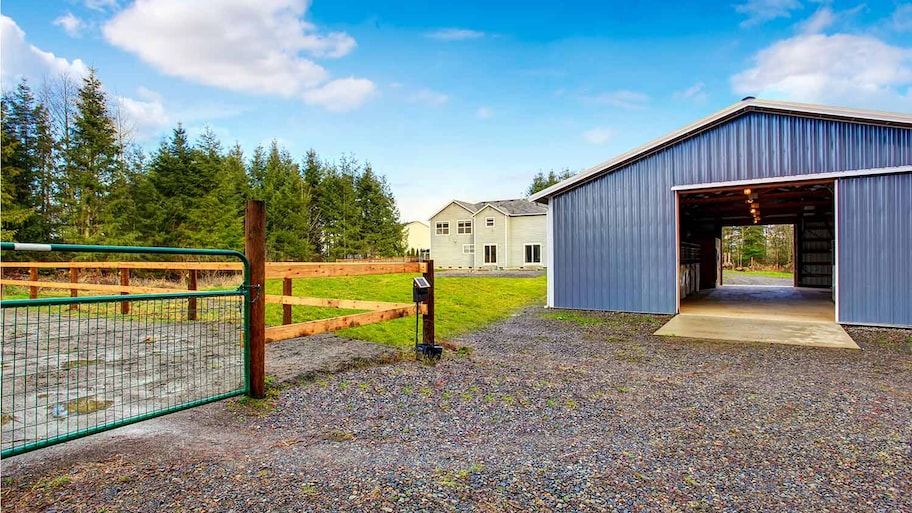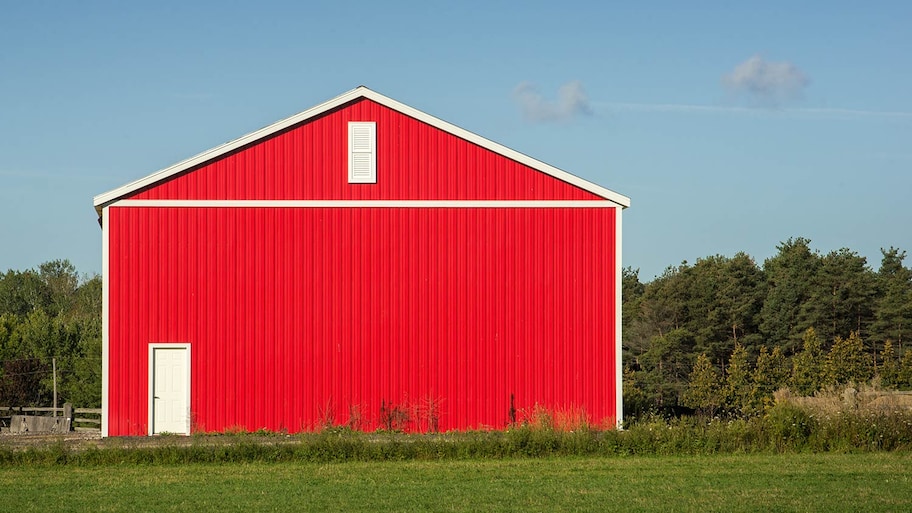What Is a Pole Barn?
Pole barn structures are more common than you may think


If you've never heard of a pole barn, you're probably wondering what it does and looks like. A pole barn offers an inexpensive and quick frame construction for both pros and DIY-ers alike. To find the answer before making any final decisions on your next project, read on.
What Is It and Why Is It Called a Pole Barn?
A pole barn is a type of post-frame construction. This method uses metal steel or wood poles and cross beams to build sturdy structures that are reliable and adaptable.
Pole buildings use posts as a framing member to anchor them a few feet deep into the ground. These serve as a critical feature of a barn's foundation, which is less costly and time-consuming to prepare than other types of construction.
Pole barns differ from a conventional home. A traditional stick-frame structure is built from the ground and includes many different pieces, not just a few posts. The foundation of the home, made of either concrete or wood, supports the entire building and keeps it in place.
In comparison, a pole barn has a high ceiling, creating an open space, and pole buildings usually don’t have basements. These versatile structures provide space for different needs, such as an alternative home, garage, or art studio.
History of Pole Barns
The name "pole barn" comes from the 1930s. A disrupted economy due to the Great Depression and Dust Bowl forced farmers in rural communities to use recycled telephone poles as their primary building materials. The farmers then called them "telephone pole barns,” which later became the shortened name: “pole barn.”
What Is a Pole Barn Used for Today?
Today's barn pole structures aren't the run-of-the-mill pole barns from the Great Depression era, as today’s options provide many style choices to fit your needs.
Buildings without any interior supporting columns are a popular farm design. But you can make pole barn structures of all sorts, including:
Commercial buildings
Residential buildings
Equine buildings
Equipment storage buildings
Multi-use structures
Pole barn garages also offer low-cost construction and easy assembly. With easy building plans and fewer materials, they're the most economically friendly option for all builders.
A pole barn is a popular option for homeowners these days because they’re so versatile and easy to put up. It’s pretty quick to get started–there are pole barn builders near you who can help turn your idea into a masterpiece.
Post Frame vs. Pole Barn: What's the Difference?
There's a lot of confusion around post-frame vs. pole barn, even though they're essentially the same thing. To make things easy, remember that post-frame construction is the building process typically used to create pole barns.
Advantages of a Pole Barn

Pole barn buildings have a few advantages over frame buildings. Here are some plus sides to building a pole barn structure:
They’re Economical
Pole buildings require less wood or steel than more traditional types of buildings. In turn, the cost is cheaper due to fewer materials and a quicker construction process.
If you do not need or want a concrete foundation, pole barns can save a lot of money. Creating a concrete foundation for other structures is usually about 10 to 20% of the overall cost and isn't necessary with pole barns.
Very Little Groundwork
One of the most challenging parts of constructing a new building is developing a foundation. They can be expensive and often require plenty of time to prepare. However, you can build pole barns without all that groundwork.
Pole barns are an ideal building option for uneven terrain, and you don't have to level before construction begins. Concrete footings must be set, but the concrete slab only needs to go through the length and width of your building.
Easier Construction and DIY-Friendly
The design of a pole building makes it much easier to construct. Because of the ease of DIY construction, you have more time and energy for other projects.
When you hire a team of professionals, your total labor costs decrease because the construction time will be shorter. Regardless of who builds it, the pole barn is still beneficial to you.
Better Insulation
A pole barn is an excellent choice when you need a building where heat and cold matter. The pole barn design allows for higher levels of insulation relative to walls with fewer breaks in the frame. Fewer breaks in framing mean less thermal transfer between your interior space and exterior weather.
Pole barns also naturally promote better ventilation so you can enjoy a more comfortable and fresh environment.
Disadvantages of Pole Barn Homes
Barn homes may seem like the best option financially and a less time-consuming one than traditional construction. But post-frame buildings include some challenges:
Design and Construction
Post-frame construction is best for square footage. You can have porches, lean-to's, and more than one roofline. However, if your building plans may require multiple wings or complex rooflines like a pitched gable end or gambrel dormer, a post-frame might not be the best option.
A post-frame is often not recommended for buildings taller than 20 feet when it comes to construction. For a building with three or more floors, you might find that conventional construction is the better option.
Poor Soil
When the soil quality is too poor or wet, post-frame construction may not be an option, either, since you must stick the posts in the ground. You wouldn't want your posts falling sideways in the mud.
Zoning
Post-frame homes can face zoning-related challenges, depending on the location. Zoning boards often do not allow steel siding or post-frame homes.
Appraisals
Post-frame homes are difficult to value since they're less common and made with fewer materials. So, cash buyers and appraisers often undervalue them based on those assumptions alone.
Lending
A concrete footing is required below the ground level when applying for a mortgage from different lenders like Fannie Mae or Freddie Mac. Because of that, you may have issues securing a lender.
